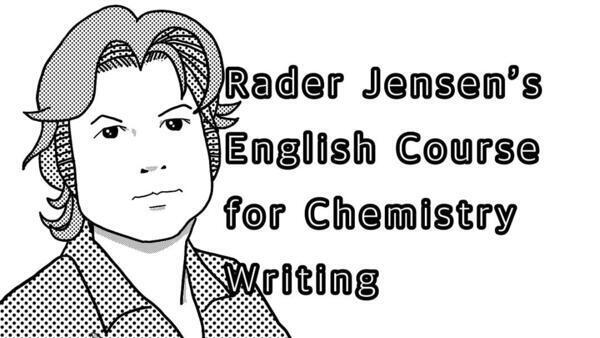[化学論文のための英語講座] 第80回:結論の復習 Review Conclusion
2025年6月16日

(English version is here.)
前回の続きとして、結論について復習します。次の例文をみて、全体の流れがスムーズになるように適切な動詞を括弧の中から選んでください。今回も、ほとんどの選択肢は文法的に正しいです。結論における適切な時制は、要旨や序論とは異なることに注意してください。
Using newly prepared, ferrocene-based ligands bearing both phosphaalkene and phosphane moieties as coordination sites, we (1 demonstrate/demonstrated/have demonstrated) that the phosphaethenyl and diarylphosphanyl groups (2 exhibit/exhibited/have exhibited) almost identical trans-influence toward Pt-Me bonds. This finding (3 is/was/has been) consistent with the comparable lone-pair orbital levels of phosphaethene and phosphane, estimated by ab initio MO calculations. On the other hand, it (4 is/was/has been) also observed that the ferrocene-based phosphaalkene ligands (5 are/were/have been) rather unstable in palladium-catalysed hydroamination of 1,3-cyclohexadiene with aniline, and readily (6 undergo/underwent/have undergone) addition of a nucleophile to give a pallada-phospha-cyclopropane as a catalytically inactive species. Although this undesirable process (7 can/could) be restrained to a considerable extent by addition of molecular sieves to the catalytic system, the observed catalytic performance (8 is/was/has been) still far from the DPCB-OMe catalyst. Previous studies strongly (9 suggest/suggested/have suggested) that the occurrence of extended π-conjugation over the DPCB skeleton (10 is/was/has been) crucial not only for the chemical stability but also for the high catalytic activity of the corresponding complexes. In this sense, the ferrocene unit (11 is/was/has been) unsuitable as a counterpart of the phosphaalkene moiety. Further development of new ligands, particularly for asymmetric catalysis (12 is/was/has been) underway.
DPCB = Diphosphinidenecyclobutene
和訳:
ホスファアルケンとホスファンの両方の部分を配位部位として持つ、新たに調製されたフェロセン配位子を使用して、ホスファエテニル基とジアリール基がPt-Me結合に対してほぼ同じトランス効果を示すことを実証した。この発見はab initio MO計算によって推定されたホスファエテンとホスファンの比較可能な孤立電子対軌道準位と一致している。一方、フェロセンを基にするホスファアルケン配位子は、1,3-シクロヘキサジエンとアニリンのパラジウム触媒によるヒドロアミノ化においてむしろ不安定であり、求核剤の付加によって容易に触媒的に不活性なパラダ-ホスファ-シクロプロパンが生じることも観察された。この望ましくないプロセスは、モレキュラーシーブを追加することでかなりの程度まで抑制できるが、観測された触媒性能はDPCB-OMe触媒にはまだまだ遠く及ばない。これまでの研究では、DPCB骨格上の拡張されたπ共役の発生が、対応する錯体の化学的安定性だけではなく、高い触媒活性にとっても重要であることが強く示唆されている。この意味では、フェロセンユニットはホスファアルケン部位のカウンターとしては不適切である。特に不斉触媒のための配位子のさらなる開発が進行中である。
DPCB = ジホスフィニデンシクロブテン
解説:
この結論は、過去の出来事や状況だけではなく、現在も繰り返されている、あるいは普遍的な出来事や状況にも言及しています。現在形、過去形、そして完了形を用いて、どのようなニュアンスを与えるかをみてみましょう。
ア. 現在形の場合:1. demonstrate, 2. exhibit, 3. is, 4. is, 5. are, 6. undergo, 7. can, 8. is, 9. suggest, 10. is, 11. is, and 12. is.
これは文法的に正しく、特に変ではありませんが、継続しており、まだ完結していないという印象を与えます。
イ. 過去形の場合:1. demonstrated, 2. exhibited, 3. was, 4. was, 5. were, 6. underwent, 7. could, 8. was, 9. suggested, 10. was, 11. was, and 12. was.
これも文法的に正しいですが、全てが過去の時点で正しく、過去に完結しているという印象を与えます。
ウ. 完了形の場合:1. have demonstrated, 2. have exhibited, 3. has been, 4. has been, 5. have been, 6. have undergone, 7. could, 8. has been, 9. have suggested, 10. has been, 11. has been, and 12. has been.
これは文法的に正しく、過去に始まった状況や行動が、現在まで続いているという印象を与えます。7 can/could は完了形がないことに注意してください。
より適切な時制を選ぶと以下のようになります:1. demonstrated, 2. exhibit, 3. is, 4. was, 5. are, 6. undergo, 7. could, 8. was, 9. suggest, 10. is, 11. is, and 12. is.
1, 4, 7, 8は状況や行動が過去に発生したという印象を与え、完了を強調しています。
2, 3, 5, 6, 9, 10, 11, 12 は進行中の状況や行動を強調します。
結論では現在形と過去形が顕著に表れていることに注意してください。実験内容は通常過去形で表現され、状態や特徴は通常現在形で表現されます。
最近の3つの復習を要約すると、柔軟性はあるものの、要旨では現在形が目立ち、序論では完了形が多く、結論では過去形と現在形が特徴的になります。
次回もどうぞお楽しみに。
As a continuation of our last exercise, let us now examine a conclusion or final summary. In the following conclusion, select verbs from within the parenthesis that provide a smooth flow through the entire paragraph. Again, most of the possibilities are grammatically correct. Keep in mind the logical choice of tense is different from that of the abstract and introduction.
Using newly prepared, ferrocene-based ligands bearing both phosphaalkene and phosphane moieties as coordination sites, we (1 demonstrate/demonstrated/have demonstrated) that the phosphaethenyl and diarylphosphanyl groups (2 exhibit/exhibited/have exhibited) almost identical trans-influence toward Pt-Me bonds. This finding (3 is/was/has been) consistent with the comparable lone-pair orbital levels of phosphaethene and phosphane, estimated by ab initio MO calculations. On the other hand, it (4 is/was/has been) also observed that the ferrocene-based phosphaalkene ligands (5 are/were/have been) rather unstable in palladium-catalysed hydroamination of 1,3-cyclohexadiene with aniline, and readily (6 undergo/underwent/have undergone) addition of a nucleophile to give a pallada-phospha-cyclopropane as a catalytically inactive species. Although this undesirable process (7 can/could) be restrained to a considerable extent by addition of molecular sieves to the catalytic system, the observed catalytic performance (8 is/was/has been) still far from the DPCB-OMe catalyst. Previous studies strongly (9 suggest/suggested/have suggested) that the occurrence of extended π-conjugation over the DPCB skeleton (10 is/was/has been) crucial not only for the chemical stability but also for the high catalytic activity of the corresponding complexes. In this sense, the ferrocene unit (11 is/was/has been) unsuitable as a counterpart of the phosphaalkene moiety. Further development of new ligands, particularly for asymmetric catalysis (12 is/was/has been) underway.
DPCB = Diphosphinidenecyclobutene
Analysis:
This hypothetical conclusion references events and conditions from the past but also current reoccurring or universal events or conditions. Let us see how it looks using the present tense, the preterit, and then the perfect in all cases.
A. present tense in all cases: 1. demonstrate, 2. exhibit, 3. is, 4. is 5. are, 6. undergo, 7. can, 8. is, 9. suggest, 10. is, 11. is and 12. is.
This is grammatically correct and does not seem strange, but it does give the feeling of being continuous and not yet complete.
B. preterit in all cases: 1. demonstrated, 2. exhibited, 3. was, 4. was, 5. were, 6. underwent, 7. could, 8. was, 9. suggested, 10. was, 11. was and 12. was.
This is also grammatically correct but gives the impression that all of these statements were correct and completed in the past.
C. perfect in all cases: 1. have demonstrated, 2. have exhibited, 3. has been, 4. has been, 5. have been, 6. have undergone, 7. could, 8. has been, 9. have suggested, 10. has been, 11. has been and 12. has been.
This is grammatically correct and gives the impression of conditions and actions that began in the past and continue to the present. Note that entry 8. can/could has no perfect form.
Selecting verb tenses that fit the time frame particularly well gives the following: 1. demonstrated, 2. exhibit, 3. is, 4. was, 5. are, 6. undergo, 7. could, 8. was, 9. suggest, 10. is, 11. is and 12. is.
Here, 1, 4, 7 and 8 give the impression that the action or condition occurred in the past and emphasise completion. 2, 3, 5, 6, 9, 10, 11 and 12 emphasise ongoing actions or conditions. Note that the conclusion features the present and preterit prominently. Here, experimental actions are typically expressed as preterit, and conditions or characteristics are typically expressed as present.
To summarise the last three lessons, although there is considerable flexibility, an abstract prominently features the present, and introduction features the perfect tenses, and the conclusion features the preterit and present.
We look forward to see in you next time.